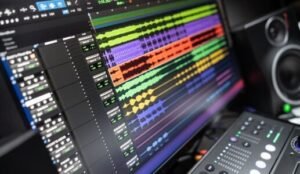 When it comes to music production, Digital Audio Workstations (DAWs) have revolutionized the way artists create, record, and produce their music. In this comprehensive guide, we will explore the history, popular models, and the timeline of DAWs, showcasing their impact on the music industry.
When it comes to music production, Digital Audio Workstations (DAWs) have revolutionized the way artists create, record, and produce their music. In this comprehensive guide, we will explore the history, popular models, and the timeline of DAWs, showcasing their impact on the music industry.
The Birth of DAWs
The concept of a DAW emerged in the 1970s when computer technology started to integrate with music production. Early pioneers like Peter Grogono and Udo Zölzer laid the foundation for what would become the modern DAW. However, it wasn’t until the 1980s that DAWs began to gain traction.
The Rise of MIDI and Sequencers
The introduction of MIDI (Musical Instrument Digital Interface) in the early 1980s was a game-changer for DAWs. MIDI allowed for the integration of various hardware and software components, enabling musicians to control synthesizers, drum machines, and other devices through a central interface. This breakthrough led to the development of sequencers, which formed the core of early DAWs.
One of the first commercially successful DAWs was the Soundstream Digital Editing System, introduced in 1978. It utilized a 24-track digital recorder and editing system, but its high cost limited its accessibility.
The 1990s: The Era of Digital Revolution
The 1990s marked a significant turning point for DAWs as technology advanced and prices became more affordable. Companies like Steinberg, Digidesign (now Avid), and Cakewalk (now BandLab) emerged as key players in the industry.
Steinberg’s Cubase, released in 1989, quickly became one of the most popular DAWs. Its intuitive interface and powerful features made it a favorite among musicians and producers. Digidesign’s Pro Tools, initially developed for recording studios, also gained popularity and became a staple in the music industry.
During this decade, DAWs started to offer multi-track recording, MIDI sequencing, and virtual instruments. The ability to manipulate audio digitally opened up endless creative possibilities for artists.
The 2000s: The Golden Age of DAWs
With the advent of the new millennium, DAWs continued to evolve and improve. The 2000s saw a surge in user-friendly interfaces, enhanced audio quality, and a wider range of software instruments and effects.
Apple’s Logic Pro, formerly known as Emagic Logic, gained popularity among Mac users, offering a comprehensive set of tools for music production. Ableton Live, introduced in 2001, revolutionized live performance and electronic music production with its unique session view and real-time capabilities.
Propellerhead Reason, with its virtual rack of devices, became a favorite among electronic music producers, while FL Studio (formerly FruityLoops) gained a strong following for its intuitive workflow and affordability.
The Present and Future of DAWs
Today, the market is flooded with a wide array of DAWs, catering to different needs and preferences. Pro Tools remains a dominant force in professional studios, while Ableton Live continues to thrive in the electronic music scene.
Other notable DAWs include Steinberg’s Cubase and Nuendo, Apple’s Logic Pro, PreSonus Studio One, and Bitwig Studio, among many others. Each DAW offers its own unique features and workflow, ensuring that musicians and producers can find the perfect fit for their creative process.
Looking ahead, the future of DAWs is promising. With advancements in technology, we can expect even more innovative features, improved integration with virtual reality and artificial intelligence, and seamless collaboration capabilities.
Conclusion
The evolution of Digital Audio Workstations (DAWs) has transformed the music production landscape. From the early days of MIDI and sequencers to the powerful and versatile software available today, DAWs have empowered musicians to unleash their creativity and produce professional-quality music from the comfort of their own studios.
As technology continues to advance, we can only imagine the exciting possibilities that lie ahead for DAWs. Whether you’re a professional producer or an aspiring artist, the world of DAWs offers endless opportunities to bring your musical vision to life.






